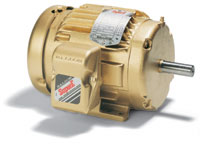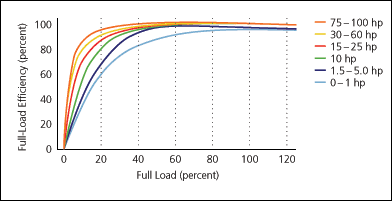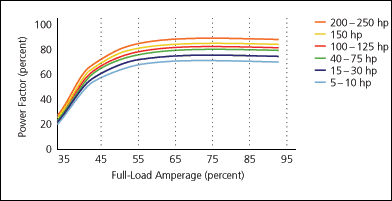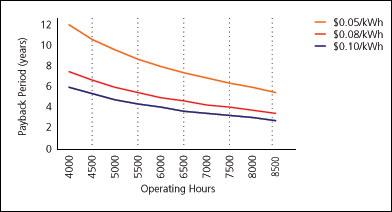ARCHIVED - Energy Efficiency in Buildings
Information Archived on the Web
Information identified as archived on the Web is for reference, research or recordkeeping purposes. It has not been altered or updated after the date of archiving. Web pages that are archived on the Web are not subject to the Government of Canada Web Standards. As per the Communications Policy of the Government of Canada, you can request alternate formats. Please "contact us" to request a format other than those available.
Premium-Efficiency Motors
Description

Figure 1 – Premium-Efficiency Motor
Electric motor systems consume large amounts of electrical energy and can provide an opportunity for significant energy savings.
Energy represents more than 97 percent of total motor operating costs over the motor's lifetime. However, the purchase of a new motor often tends to be driven by the price, not the electricity it will consume. Even a small improvement in efficiency could result in significant energy and cost savings. Investing a little more money upfront for a more efficient motor is often paid back in energy savings. Improving energy efficiency reduces greenhouse gas emissions that contribute to climate change.
Organizations should have a back-up plan in place to deal with motor failures. When a motor fails is often the best opportunity to install a more efficient motor, rather than repairing it.
Technical Specifications
Motors turn electrical energy into mechanical energy. Motor efficiency is the ratio of mechanical power output to electrical power input. In other words, motor efficiency represents the percent of input energy that is converted into useful work.
A motor's nameplate rating is based on output horsepower (hp), which is fixed for continuous operation at full load. The amount of input power needed to produce the rated horsepower will vary from motor to motor, with more-efficient motors requiring less input wattage than less-efficient models to produce the same output.
The energy consumption of a motor is determined by three factors. The relationship is as follows:
Energy Consumption = (Operating Hours x Load) ÷ Motor Efficiency
As demonstrated in the equation above, a higher level of efficiency results in an overall reduced level of consumption.
Motor efficiency varies with load. The efficiency of motors typically peaks at close to 75 percent of full load and is relatively flat down to a 50 percent load point (see Graph 1).

Most motors are operated at 60 to 75 percent of their rated capacity.
Oversized motors have a lower rate of efficiency when they are in operation. A motor that is operating at a 35 percent load is less efficient than a smaller motor that is matched to the same load.
When motors operate near their rated load, the power factor (PF) is high. For lightly loaded motors, the PF drops significantly (see Graph 2). In addition to increased electrical costs, a lower PF may reduce the building's voltage, increase electrical distribution system losses and reduce the system's capacity to deliver electrical energy.
| Table 1 – NEMA Nominal Full-Load Efficiencies for Selected Induction Motors (600 Volts or Less) | |||
| ODP* 1200 RPM (6 Pole)** | |||
| Horsepower | Standard*** | Energy Efficient | Premium Efficiency |
|---|---|---|---|
| 5 | 87.5 | 89.5 | |
| 7.5 | 88.5 | 90.2 | |
| 10 | 87.3 | 90.2 | 91.7 |
| 15 | 87.4 | 90.2 | 91.7 |
| 20 | 88.5 | 91.0 | 92.4 |
| 25 | 89.4 | 91.7 | 93.0 |
| 30 | 89.2 | 92.4 | 93.6 |
| 40 | 90.1 | 93.0 | 94.1 |
| 50 | 90.7 | 93.0 | 94.1 |
| 75 | 92.0 | 93.6 | 94.5 |
| 100 | 92.3 | 94.1 | 95.0 |
| 125 | 92.6 | 94.1 | 95.0 |
| 150 | 93.1 | 94.5 | 95.4 |
| 200 | 94.1 | 94.5 | 95.4 |
| TEFC* 1800 RPM (4 Pole)** | |||
| Horsepower | Standard*** | Energy Efficient | Premium Efficiency |
| 5 | 87.5 | 89.5 | |
| 7.5 | 89.5 | 91.7 | |
| 10 | 87.0 | 89.5 | 91.7 |
| 15 | 88.2 | 91.0 | 92.4 |
| 20 | 89.6 | 91.0 | 93.0 |
| 25 | 90.0 | 92.4 | 93.6 |
| 30 | 90.6 | 92.4 | 93.6 |
| 40 | 90.7 | 93.0 | 94.1 |
| 50 | 91.6 | 93.0 | 94.5 |
| 75 | 92.2 | 94.1 | 95.4 |
| 100 | 92.3 | 94.5 | 95.4 |
| 125 | 92.6 | 94.5 | 95.4 |
| 150 | 93.3 | 95.0 | 95.8 |
| 200 | 94.2 | 95.0 | 96.2 |
|
* Open drip-proof (ODP) and totally enclosed fan-cooled (TEFC) motors use different methods to remove heat from the windings. ODP motors have an internally mounted fan that allows air to blow directly through the motor and has a cover that prevents drops of liquid from entering (suitable for protected environments). TEFC motors use an externally mounted fan that draws air over the case to provide cooling and are designed to prevent outside air from flowing into the frame (motors can function outdoors and in dusty or contaminated environments). ** Motors are available at rated synchronous speeds that are determined by the number of poles for which the motor is wound and the frequency of the power supply. The synchronous speed is calculated from this formula: Revolutions per minute (RPM) = (120 x Frequency) ÷ Number of Motor Winding Poles. For 60-hertz frequency, the synchronous speeds are as follow: 2 poles = 3600 RPM, 4 poles = 1800 RPM, 6 poles = 1200 RPM. *** The values are average full-load efficiency for standard motors and may be used as an estimate when the manufacturer cannot provide actual motor efficiency values. (Source: U.S. Department of Energy) |
|||

While motor full- and part-load PF characteristics are important, they are not as significant as efficiency. When selecting a motor, current practice is to purchase for efficiency and correct for PF.
When a motor is oversized and lightly loaded, the PF will be lower compared with a motor that is sized properly. A facility with many induction motors and a low PF may address this issue by replacing motors with premium-efficiency motors that are properly sized.
In the motor marketplace, three terms are used to label motors: “high-efficiency,” “energy-efficient” and “premium-efficiency.” Only the last two terms have definitions established by the National Electrical Manufacturers Association (NEMA1). In 1989, NEMA first developed and adopted energy-efficient performance values in its MG-1 standard (Motors & Generators-1), which was incorporated in Canada's Energy Efficiency Regulations in 1997 for minimum efficiency levels on certain 1-200 hp motors. In 2001, NEMA launched the NEMA Premium™ Efficiency Electric Motors Program, which covered many more motor types and sizes.
The Canadian Standards Association (CSA) developed a Canadian standard in 1993 and updated it in 1998. CAN/CSA-C390 set the requirement for minimum efficiency for new motors made or sold in Canada at the same value as the NEMA “energy-efficient” level.
Nominal efficiency levels for both “energy-efficient” and “premium-efficiency” motors for some selected types and sizes are presented in Table 1. (The entire table is available through NEMA).
Energy Information
To calculate the annual energy consumption and cost savings from replacing a motor with a higher-efficiency one, the formula in Box 1 should be used.
The motor horsepower can be obtained from the nameplate, and the efficiencies for the existing and replacement motors can be obtained from manufacturers or suppliers.
The load factor in the equation must be determined by using an electrical measurement instrument when the motor is running in its normal operating mode. The equation shown in Box 2 is used for three-phase motors to determine the load factor.
Most electrical measurement instruments can determine power directly. If they cannot, by measuring the voltage, current and PF, the equation in Box 3 may be used for three-phase motors to determine power. To determine the input power at full-rated load, the equation in Box 4 is used.
| Table 2– Comparison of Various-Sized Motors | ||||||||
| Standard Efficiency | ||||||||
|
HP
|
||||||||
| Data | 5 | 7.5 | 10 | 15 | 20 | 25 | 30 | 50 |
|---|---|---|---|---|---|---|---|---|
| Efficiency at 75% Load | 84.0 | 86.0 | 88.4 | 89.3 | 90.8 | 90.9 | 91.6 | 91.8 |
| Annual Consumption (kWh) | 24 978 | 36 595 | 47 469 | 70 486 | 92 428 | 115 408 | 137 432 | 228 554 |
| Annual Cost ($) | 1,499 | 2,196 | 2,848 | 4,229 | 5,546 | 6,925 | 8,246 | 13,713 |
| NEMA Premium-Efficiency | ||||||||
|
HP
|
||||||||
| Data | 5 | 7.5 | 10 | 15 | 20 | 25 | 30 | 50 |
| Efficiency at 75% Load | 90.7 | 91.9 | 92.4 | 92.6 | 93.1 | 93.6 | 94.4 | 94.9 |
| Annual Consumption (kWh) | 23 133 | 32 246 | 45 414 | 67 974 | 90 145 | 112 079 | 133 355 | 221 088 |
| Annual Cost ($) | 1,388 | 2,055 | 2,725 | 4,078 | 5,409 | 6,725 | 8,001 | 13,265 |
| Annual Savings (kWh) | 1 845 | 2 349 | 2 055 | 2 512 | 2 283 | 3 329 | 4 077 | 7 466 |
| Annual Savings ($) | 111 | 141 | 123 | 151 | 137 | 200 | 245 | 448 |
| List Price ($) | 533 | 724 | 814 | 996 | 1,294 | 1,700 | 1,771 | 2,751 |
| Purchase Price ($) | 426 | 579 | 651 | 797 | 1,035 | 1,360 | 1,417 | 2,201 |
| Payback (years) | 3.9 | 4.1 | 5.3 | 5.3 | 7.6 | 6.8 | 5.8 | 4.9 |
Boxes 1 to 4 – Energy Information
Demand savings (kW) = (hp x 0.746) x (LF) x (1/Eexist – 1/Ereplace)
Consumption savings (kWh) = (Demand savings) x (Operating hours)
Annual cost savings = (kWh savings x kWh rate)
Where:
hp = motor nameplate horsepower
0.746 = conversion from hp to kW
LF = load factor as percent of full-rated load (e.g. 70 percent, 80 percent)
Eexist and Ereplace = efficiency of existing and replacement motors (in percent)
LF = (PI ÷ PIR)
Where:
PI = measured three-phase input power (in kW)
PIR = input power at full-rated load (in kW)
PI = (V x I x PF x 1.732) ÷ 1000
Where:
PI = power (in kW)
V = voltage, mean line-to-line of three phases
I = current (in A), mean of three phases
PF = power factor (in percent)
PIR = (hp x 0.746) ÷ EFF
Where:
PIR = input power at full-rated load (in kW)
hp = horsepower from nameplate
EFF = efficiency at full-rated load
Caution: If energy-efficient motors are misapplied, they may not achieve predicted energy savings and may actually result in diminished performance and reduced motor life. Any motor selection must be properly engineered for its intended application. For centrifugal fans and pumps, an increase in operating speed will increase the required power by the third power of the speed ratio. For example, by increasing the speed by only 25 RPM – from 1740 to 1765 RPM – a 4.4 percent increase in the load will be placed upon a motor, i.e. (1765 ÷ 1740)3 = (1.014)3 = 1.044. On average, energy-efficient motors have higher full-load speeds than standard motors. When replacing a standard-efficiency motor, a high-efficiency motor with lower or equal full-load speed must be selected to avoid the energy increase that may negate the predicted energy savings resulting from a higher efficiency. To provide the correct flow, it may be necessary to adjust fan sheaves or pump-impeller diameters.
MotorMaster+ (Version 4.0) software, developed by Washington State University and funded by the U.S. Department of Energy (DOE), is a popular and free tool to calculate the savings for premium-efficiency motors. Through its comprehensive and regularly updated databases, it helps estimate the efficiency of existing motors and provides performance and price list (in U.S. dollars) of premium-efficiency motors.
Comparison
The initial cost of a premium-efficiency motor will typically be 15 to 30 percent more than an energy-efficient one.
In addition to the energy savings, premium-efficiency and energy-efficient motors offer other benefits. In general, they are of a higher quality, are more reliable, last longer, have longer warranties, run more quietly and cooly and produce less waste heat than their less-efficient counterparts.
Premium-efficiency and energy-efficient motors may be more suited for use with a variable speed drive than their standard-efficiency counterparts. (Specify “inverter rated” when purchasing a motor for use with a variable speed drive.)
Table 2 was created in 2003 to compare various-sized motors. The comparison is based on replacing an in-service standard-efficiency motor with a motor that meets the requirements for a premium-efficiency designation. All motors are 230V/460V, 1800 RPM (four poles), TEFC, general purpose, NEMA Design A or B types. Cost comparisons are based on 7500 annual hours at 75 percent of rated power (load factor = 75 percent), and a $0.06/kWh utility rate. A dealer discount of 20 percent was assumed for the purchase price.
Case Study
A three-phase, 10-hp motor running for 6000 hours per year has an efficiency of 87 percent at full load. To find the load factor, an electrician takes the following measurements:
| Vab = 463V | Ia = 11.5 A | PFa = 0.70 |
| Vbc = 467 V | Ib = 11.0 A | PFb = 0.72 |
| Vca = 459 V | Ic = 11.4 A | PFc = 0.71 |
Using the equations on page 3, Boxes 1 to 4, the load factor is calculated to be 75 percent, as follows:
|
V = (463 + 467 + 459) ÷ 3 = 463 V
|
|
I = (11.5 + 11.0 + 11.4) ÷ 3 = 11.3 A
|
|
PF = (0.70 + 0.72 + 0.71) ÷ 3 = 0.71
|
|
PI = (463 x 11.3 x 0.71 x 1.732) ÷ 1000 = 6.43 kW
|
|
PIR = (10 x 0.746) ÷ 0.87 = 8.57 kW
|
|
LF = 6.43 ÷ 8.57 = 0.75
|
The manufacturer's data shows that the motor efficiency at 75 percent load is 88.4 percent efficient. The facility manager finds a premium-efficiency motor with an efficiency of 92.4 percent at 75 percent load with an installed cost of $650. The utility rate is $0.08 per kWh, and there is no demand charge. The following calculations show the payback for the replacement:
| Demand savings (kW) | = (hp x 0.746) x LF x (1/Eexist – 1/Ereplace) |
| = (10 x 0.746) x (0.75) x (1 ÷ 0.884 – 1 ÷ 0.924) | |
| = 0.27 kW | |
| Annual cost savings | = 0.27 kW x 6000 hours x $0.08 per kWh |
| = $132 | |
| Payback | = $650 ÷ $132 |
| = 4.9 years |
For the case study information (10 hp, efficiency gain of 4 percent), Graph 3 shows the effect of operating hours and utility rates on the simple payback when replacing a standard motor with a premium-efficiency motor.

The Energy Innovators Initiative, part of Natural Resources Canada's Office of Energy Efficiency, helps commercial businesses and public institutions improve energy efficiency and reduce greenhouse gas emissions that contribute climate change.
1NEMA is a trade association that establishes standards to help in the selection and application of electric motors and other electrical equipment.
You can find other buildings publications from the Office of Energy Efficiency. To order paper copies, or to discuss how we can help you make your property more energy efficient, please contact us.
Office of Energy Efficiency
Natural Resources Canada
580 Booth Street, 18th floor
Ottawa ON K1A 0E4
Tel.: 877-360-5500 (toll free)
Fax: 613-947-4121
Web site
Page details
- Date modified: